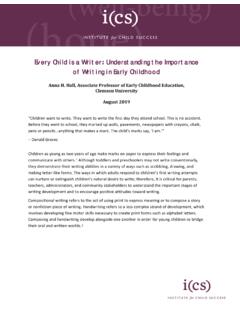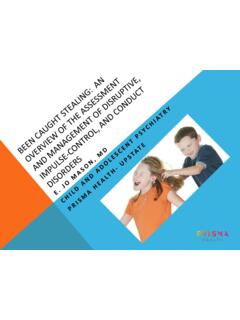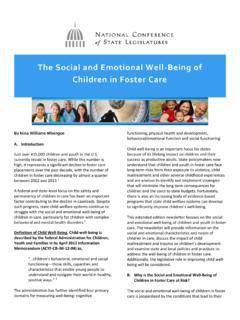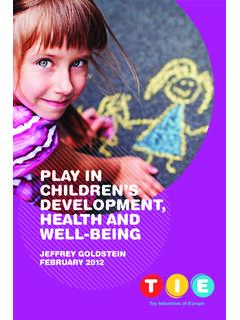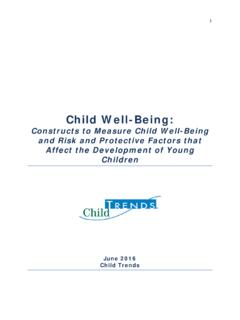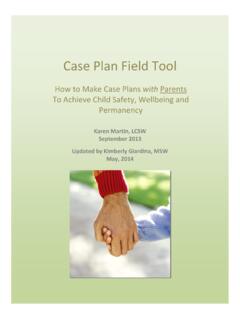Transcription of WHAT IS SUSTAINED SHARED THINKING? - Institute for Child ...
1 WHAT IS SUSTAINED SHARED THINKING? An episode in which two or more individuals work together in an intellectual way to resolve a problem, clarify a concept, evaluate activities, extend a narrative etc. Both parties must contribute to the thinking and it must develop and extend (Siraj-Blatchford et al., 2002). INTRODUCTION TO THE SCALE. What is the evidence base and background? Why a new scale? Current research using, and on the SSTEW scale INTERNATIONAL AND NATIONAL EVIDENCE. Early experiences: Lay the foundation for all learning (Sylva et al., 2004: Allen, 2011). Can reduce inequalities linked to parental background and socio-economic status (West et al., 2010: Manning et al., 2010). Can have a profound effect on economic growth and prosperity generally (Melhuish et al, 2010: Field, 2010: EIU, 2012).
2 SO WHAT ARE WE LOOKING FOR? What aspects of early years provision and practice constitute high quality What is the impact of this? WHY THE EARLY YEARS? If the race is already halfway run even before children begin school, then we clearly need to examine what happens in the earliest years . (Epsing-Andersen, 2005). Like it or not, the most important mental and behavioural patterns, once established are difficult to change once children enter school . (Heckman & Wax, 2004). EARLY CHILDHOOD ENVIRONMENT RATING SCALES. ECERS-3 ITERS ECERS-E. A family' of documents All grounded in validated research Can be used as an audit tool for assessment Can be used as a self-evaluation tool for identifying improvement QUALITY, PEDAGOGY & PRACTICE. New understandings of early childhood development and practice from REPEY (Researching effective pedagogy in the early years) showed that children benefit when: Strong leadership and relatively little staff turnover Adults have warm, responsive relationships with children High quality interactions including SUSTAINED SHARED Thinking Trained teachers are amongst the staff Parents are supported in involvement in children's learning Siraj-Blatchford et al.
3 2001. STUDY OF EARLY EDUCATION AND. DEVELOPMENT (SEED). Includes a longitudinal study of 5,000+. households with a two-year old Child Interviews with parent when Child aged 2, 3 and 4. Questions on family, Child 's health and development Assessment of Child 's cognitive, language and social development from 2 to 7 years Parents as Home-based Pedagogues Early years Home Learning Environment (HLE). being read to painting and drawing going to the library playing with letters/numbers learning activities with the alphabet learning activities with numbers/shapes learning activities with songs/poems/nursery rhymes THOUGHTS ON LANGUAGE DEVELOPMENT . WHAT DOES THIS LOOK For two year olds? For three and four year olds? NEW SSTEW SCALE. It is another scale in the current toolkit' of quality assessment rating scales It is for use in settings with children aged 2 5.
4 Years Has a focus on observing interactions Is an aspirational tool NATURE OF THE SSTEW SCALE. Builds on ECERS R & ECERS E/ITERS R. Considers high quality interactions with and between children. Needs to be used by someone with knowledge of Child development and appropriate practice SUSTAINED SHARED THINKING HOW. DO WE SUPPORT THIS? They may include the adult: Tuning in: listening carefully to what is being said, observing body language and what the Child is doing Showing genuine interest: giving your whole attention, maintaining eye contact, affirming, smiling, nodding Respecting children's own decisions and choices inviting children to elaborate: I really want to know more about this'..MORE ON SST. Inviting children to elaborate: I really want to know more about this'. Recapping: so you think '.
5 Offering your own experience: I like to listen to music when I. cook supper at home'. Clarifying ideas: Right Darren, so you think this stone will melt if I boil it in water?'..MORE ON SST. Suggesting: You might like to try doing it this way'. Reminding: Don't forget that you said that this stone will melt if I boil it'. Using encouragement to further thinking: you have really thought hard about where to put this door in the palace but where on earth will you put the windows?'. Offering and alternative viewpoint: Maybe Goldilocks wasn't naughty when she ate the porridge'. Speculating: Do you think the three bears would have liked Goldilocks to come and live with them as their friend?'. Adult Child Interactions A few four-year-olds were sitting together. Three of the children were wearing trainers that would light up when they stepped down on them: Teacher: Wow!
6 Look at your shoes! That is so cool. They light up when you step down. Child 1: Yes, they do this. [Jumps up and down several times]. Teacher: How does that happen? How does it light up? Child 1: Because they are new. Teacher: Um. Mine are new too but they don't light up. Child 2: No, because they light up when you step down on them. [Steps down hard several times]. Teacher: [Steps down hard several times] That's funny. Mine don't light up when I. step down. Child 3: No, no, no, you have to have these holes [points to the holes]. Teacher: [Pointing to the holes in her own shoe] But I have holes and mine still don't light up, and Josh has holes in his trainers too and his do not light up either. I wonder why? Child 4: I think you need batteries. Kids, you need batteries. Child 1: Yeah, you need batteries to make them work.
7 [Thinks for a while]. But I did not see batteries when I put my toes in. Child 4: I think they are under the toes. Child 2: I can't feel the batteries under my toes. Teacher: I wonder how we can find out about this? COMMENT, COMMENT, COMMENT, COMMENT & QUESTION ???? High Scope method advocates sparing use of questions. The adults use comment and only question when this stimulates the conversation. They ask children to explain their thinking, and engage in metacognition', talking about their own thinking and reasoning. BLOOM'S TAXONOMY. LET'S LOOK AT SUBSCALE 1 - ITEM 1 .. Subscale 1 Building trust, confidence and independence'. Item 1 Self-regulation and social development'. LET'S LOOK AT SUBSCALE 4 - ITEM 10 .. Subcale 4 - Supporting learning & critical thinking'. Item 10 Encouraging SST through storytelling, sharing books, singing and rhymes'.
8 THE ROLE OF THE OBSERVER .. Looking at/for interactions between children and adults, as well as children with children. Considering how the adult/s support and extend learning which will include their responsiveness to individual children as well as to small groups and all of the children. CURRENT RESEARCH .. Study of Early Education and Development (SEED). UK based study following 2 year olds using ITERS, ECERS & SSTEW. Research in Australia & New Zealand using the SSTEW scale AND FINALLY .. REFERENCES. Siraj I, Kingston D, Melhuish E Assessing Quality in Early Childhood Education and Care SUSTAINED SHARED Thinking and Emotional well -being (SSTEW) Scale for 2-5-year-olds provision.(2015). Harms T., Clifford RM and Cryer D. Early Childhood Environment Rating Scale . Revised Edition (ECERS-R)(2005) and Infant/toddler Environment Rating Scale (ITERS-I) (2003).
9 Kingston D and Siraj I. Powerful Pedagogies: enhancing quality interactions and well -being through early childhood education (2016). Siraj-Blatchford I, SylvaK. Muttock S, Gilden R and Bell D, Researching Effective Pedagogy in the Early Years (2002). Siraj-Blatchford I, Conceptualising progression in the pedagogy of play and SUSTAINED SHARED thinking in early childhood education: (2009). Sylva K, Melthuish E, Sammons P, Siraj-Blatchford I and Taggart B. Effective Pre-school Provision (2004) DfES Publications CONTACTS: Mary MacKenzie SSTEW Publishers: Institute of Education Press 20 Bedford Way London WC1 OAL. THANK YOU ANY QUESTIONS?
